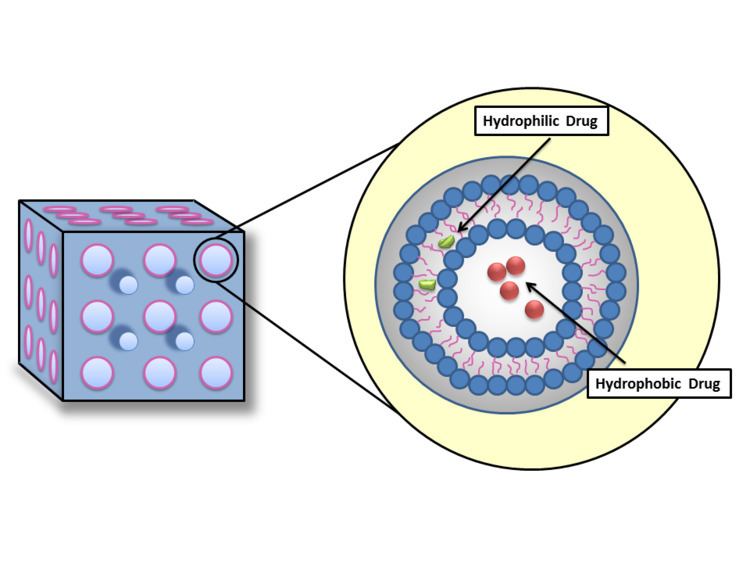 | ||
Cubosomes are discrete, sub-micron, nanostructured particles of the biscontinuous cubic liquid crystalline phase. The term "biscontinuous" refers to two distinct hydrophilic regions separated by the bilayer. Biscontinuous cubic crystalline materials have been an active research topic because their structure lends itself well to controlled-release applications.
Contents
Cubosomes are liquid crystalline nano-structures formed from the cubic phase of lipids, such as monooleate, or any other amphiphilic macromolecules with the unique property to be dispersed into particles. In short, the emulsification of the cubic lipid phases in water results in production of cubosomes that can be defined as nanoparticulate dispersal systems characterized by high biocompatibility and bioadhesivity. They are formed by the mixture of phospholipid (glycerol monooleate) and non-ionic surfactant in aqueous media by applying high energy dispersion such as sonication and homogenization. Nano-vehicles are generated from a self-assembled lipid mixture and studied by means of high-resolution cryogenic transmission electron microscope (cryo-TEM). These structures have been observed to naturally occur in mitochondrial membranes and in stressed cells.
Cubosomes are formed at controlled temperatures into lipid bi-layer twisted into three dimension with minimal surface forming a tightly packed structure with bicontinuous domains of water and lipid. There are three different proposed phases that these cubic structures can be in: the P-surface, G-surface and D-surface for primitive, gyroid and diamond structures respectively. This variation in structure allows for cubosomes to be the ultimate drug delivery system due to its ability to maintain the structural integrity of the ingredients that it carries. The uses of cubosomes are still being researched but they range from systems for efficient drug delivery into specific body systems to stabilizing and producing palladium nanoparticles.
Formation
Cubosomes are nanoparticles and are produced by using nanotechnology. There are two different techniques that are most commonly used for making nanoparticle devices.
The "top-down technique" or high-energy techniques require formation of cubosomes prior to their use in a product. It is used whereby bulk cubic phase is first produced and then dispersed by high energy processing into cubosome nanoparticles. Unfortunately, even most up-to-date information give little or no information regarding the mechanism underlying cubosome formation by energetic dispersion of bulk cubic phases. Most cubosome research over the last two decades have been focused on this technique. However, high energy processes are expensive, can be difficult to scale-up, and harmful to fragile temperature-sensitive active ingredients like proteins all of which add more challenges to an in-depth understanding of cubosomes as well as their production.
The "bottom-up techniques" avoid high-energy drawbacks and allow formation of cubosomes in use by a consumer or during product formulation. This technique has some advantages but the major disadvantage is that although more stable cubosomes are formed, some unwanted vesicles byproduct are also formed.
Uses
For most fluids and some homogenous solid materials, like gels, diffusion is the same in all directions and characterized by the same diffusion coefficient number. This property is called isotropicity which gives cubosomes the ability to be used in biological tissues which are highly structured and typically have different diffusion coefficients along different directions (anisotropic). Because of advantages such as the unique structure of the cubic phase and its resemblance to biological membranes as well as biodegradability of lipids, cubosomes are a great tool for drug delivery system. In addition, the bicontinuous cubic liquid crystalline phase (cubic phase)’s tortuosity is useful for slowing down diffusion as shown by Higuchi’s square root of time release kinetics. Capability to encapsulate hydrophilic, hydrophobic, and amphiphilic substance, being simple to prepare, and all the aforementioned qualities give cubosomes a property that can be used in controlled transport applications as drug delivery vehicles. For example, the application of cubosomes is very promising for melanoma treatment. Nonetheless, there are some disadvantages and challenges associated with this kind of delivery system. Incorporating a drug in cubic phase may cause phase transformation which may affect the release of the drug causing shorter release duration. Also, the cubic gel’s high viscosity considerably limits its large-scale production
